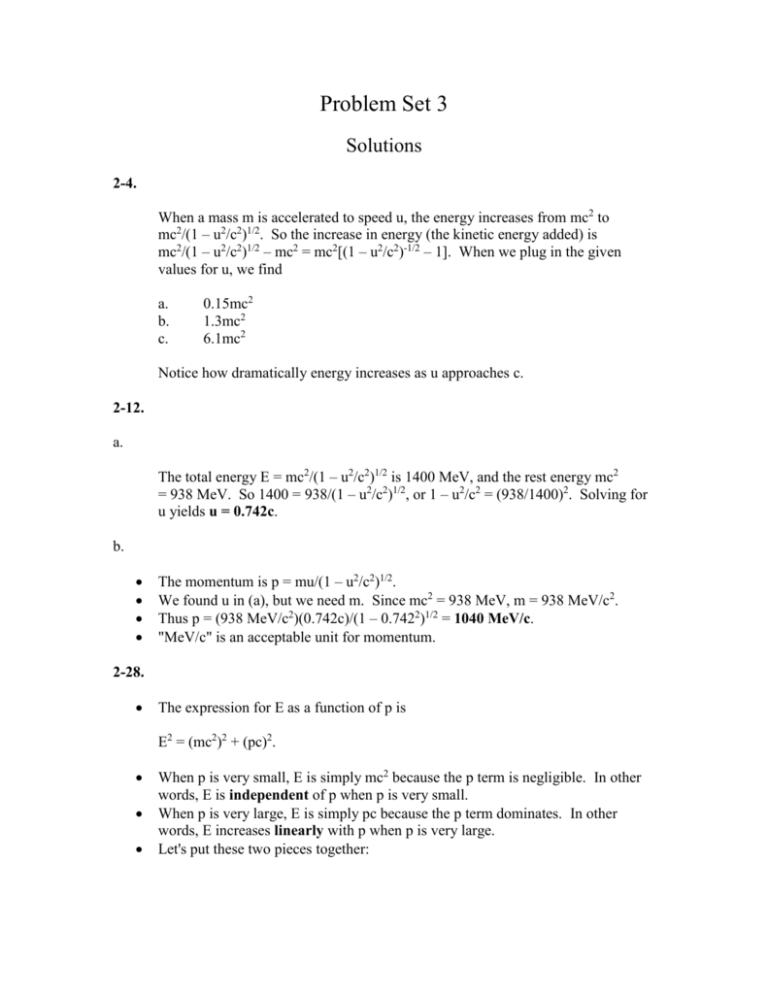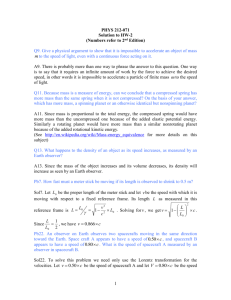Problem Set 3
advertisement

Problem Set 3 Solutions 2-4. When a mass m is accelerated to speed u, the energy increases from mc2 to mc2/(1 – u2/c2)1/2. So the increase in energy (the kinetic energy added) is mc2/(1 – u2/c2)1/2 – mc2 = mc2[(1 – u2/c2)-1/2 – 1]. When we plug in the given values for u, we find a. b. c. 0.15mc2 1.3mc2 6.1mc2 Notice how dramatically energy increases as u approaches c. 2-12. a. The total energy E = mc2/(1 – u2/c2)1/2 is 1400 MeV, and the rest energy mc2 = 938 MeV. So 1400 = 938/(1 – u2/c2)1/2, or 1 – u2/c2 = (938/1400)2. Solving for u yields u = 0.742c. b. The momentum is p = mu/(1 – u2/c2)1/2. We found u in (a), but we need m. Since mc2 = 938 MeV, m = 938 MeV/c2. Thus p = (938 MeV/c2)(0.742c)/(1 – 0.7422)1/2 = 1040 MeV/c. "MeV/c" is an acceptable unit for momentum. 2-28. The expression for E as a function of p is E2 = (mc2)2 + (pc)2. When p is very small, E is simply mc2 because the p term is negligible. In other words, E is independent of p when p is very small. When p is very large, E is simply pc because the p term dominates. In other words, E increases linearly with p when p is very large. Let's put these two pieces together: E high p: E = pc low p: E = mc2 intermediate p: no simple equation, but we can connect the two other pieces p 2-44. Before the creation of the two particles, there is a photon with momentum p and energy pc. The photon is annihilated as the particles are created, so all the photon's initial momentum and energy must appear in the two particles. If the photon travels in the x direction, the vector sum of the momentum of the two particles must also been in the x direction: electron photon positron The electron and positron each have momentum mu/(1 – u2/c2)1/2. Each momentum has x-component (mu)cos/(1 – u2/c2)1/2, so the final total momentum in the x direction is 2(mu)cos/(1 – u2/c2)1/2. Each particle has energy mc2/(1 – u2/c2)1/2, so the final total energy is 2mc2/(1 – u2/c2)1/2. First we equate initial and final momentum: p = 2(mu)cos/(1 – u2/c2)1/2. Now we equate initial and final energy: pc = 2mc2/(1 – u2/c2)1/2, which simplifies to p = 2mc/(1 – u2/c2)1/2. So each conservation law (momentum and energy) has given us an expression for p. Are the two expressions consistent with other? Let's equate one with the other: 2(mu)cos/(1 – u2/c2)1/2 = 2mc/(1 – u2/c2)1/2, which simplifies to ucos = c u is less than c and cos is less than 1, so the above equation can never be true. So the conservation laws make it impossible for a photon in isolation to generate an electron-positron pair. 2-46. a. y y' u x -u x' In the S frame (shown above), both particles have speed u (in opposite directions). We want to know the speed of the particle on the left as seen by the particle on the right (the S' frame above). The S' frame moves with velocity v = -u in the S frame, and the particle on the right moves with velocity ux = u in the S frame, so we can use the velocity transformation: u' u x ' ux v u (u ) 2u . vux (u )u 1 u 2 / c 2 1 2 1 2 c c So 2 u'2 2u 1 2 1 / c2 2 2 c 1 u / c 2u / c 1 2 2 1 u / c 1 u 2 2u / c 1 u / c 2 / c2 2 2 2 2 1 2u 2 / c 2 u 4 / c 4 4u 2 / c 2 1 u2 / c2 1 2u 2 / c 2 u 4 / c 4 1 u2 / c2 1 u2 / c2 1 u2 / c2 2 b. In frame S', the particle attached to the S' frame has no momentum, and the other particle has momentum mu'/(1 - u'2/c2)1/2, and we use the final result of (a) to rewrite the denominator: p' = mu'/(1 - u'2/c2)1/2 = mu'(1 + u2/c2)/(1 – u2/c2) by the final result of (a) = m[2u/(1 + u2/c2 )](1 + u2/c2)/(1 – u2/c2) = 2mu/(1 – u2/c2) c. The initial momentum in S' is shown above: 2mu/(1 – u2/c2). The final momentum is Mu/(1 – u2/c2)1/2. Equate initial and final momentum (conservation of momentum): Mu/(1 – u2/c2)1/2 = 2mu/(1 – u2/c2) M = 2m/(1 – u2/c2)1/2 d. In frame S, the initial energy is 2mc2/(1 – u2/c2)1/2 because each particle has speed u. The final energy is Mc2 because the composite particle is at rest in S. Substituting M = 2m/(1 – u2/c2)1/2 immediately shows the equivalence. In frame S', the initial energy is mc2 + mc2/(1 – u'2/c2)1/2 because one particle is at rest and the other moves with speed u'. The final energy is Mc2/(1 – u2/c2)1/2 because the composite particle moves with speed u. The initial energy can by simplified by the result of (a): mc2 + mc2/(1 – u'2/c2)1/2 = mc2 + mc2(1 + u2/c2)/(1 – u2/c2) = mc2[(1 – u2/c2) + (1 + u2/c2)]/(1 – u2/c2) = 2mc2/(1 – u2/c2) The final energy can be simplified by plugging M = 2m/(1 – u2/c2)1/2 into the expression for the final energy: Mc2/(1 – u2/c2)1/2 = [2m/(1 – u2/c2)1/2]c2/(1 – u2/c2)1/2, which is clearly equal to the value for initial energy found above. Notice the energy is conserved (it's the same before and after collisions as seen by any inertial observer) but not invariant (since each reference frame finds a different value). 2-47. a. In the zero-momentum frame, two protons have equal and opposite momenta. So their velocities are u, and their momenta are mu/(1 – u2/c2)1/2. The kinetic energy of each proton is mc2/(1 – u2/c2)1/2 – mc2, so the total kinetic energy is 2mc2/(1 – u2/c2)1/2 – 2mc2. We are told that this total kinetic energy is 2mc2, so we can write 2mc2/(1 – u2/c2)1/2 – 2mc2 = 2mc2 1/(1 – u2/c2)1/2 – 1 = 1 1/(1 – u2/c2)1/2 = 2 1/(1 – u2/c2) = 4 1 – u2/c2 = ¼ u2/c2 = ¾ u = c(3)1/2/2 b. In the zero-momentum frame (S), we have this: y y' u Lab x' Notice that the proton on the right is in the lab frame (S'); in the lab frame, one of the protons is initially at rest, and the other approaches with speed u'. We want to find u' using the relativistic velocity transformation, knowing that the S' frame moves with velocity v = -u in the S frame, and the particle on the right moves with velocity ux = u in the S frame: u' u x ' -u x ux v u (u ) 2u . vux (u )u 1 u 2 / c 2 1 2 1 2 c c We now use the value of u found in (a): u' 2u 2 c 3/2 c 3 4c 3 2 2 2 7 1 u / c 1 c 3 / 2 / c2 1 3/ 4 c. We simply use Ek = mc2/(1 – u'2/c2)1/2 – mc2: Ek = mc2/(1 – u'2/c2)1/2 – mc2 = mc2/[1 – (48c2/49)/c2]1/2 – mc2 = mc2/(1/49)1/2 – mc2 = 7mc2 – mc2 = 6mc2








